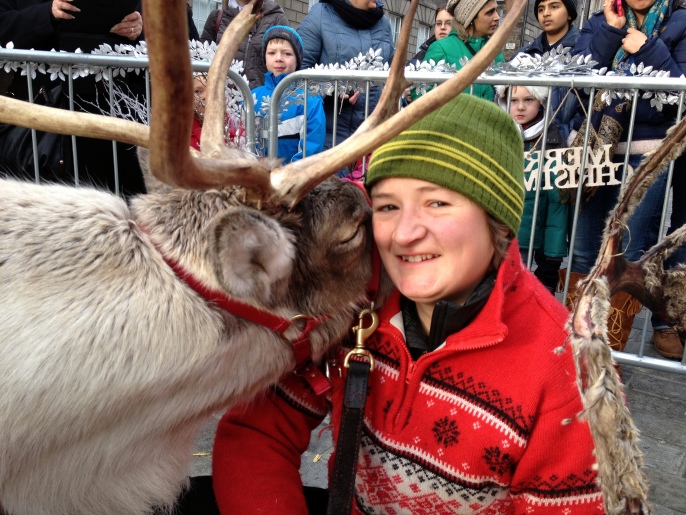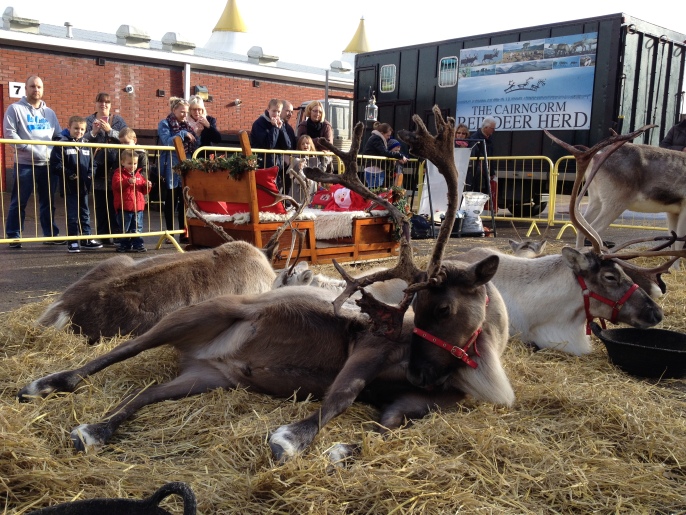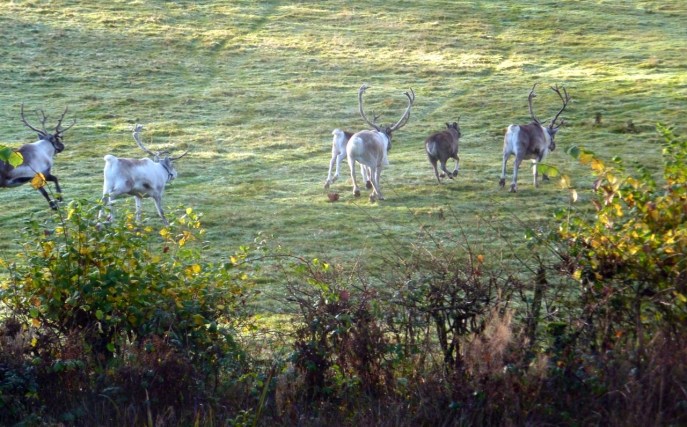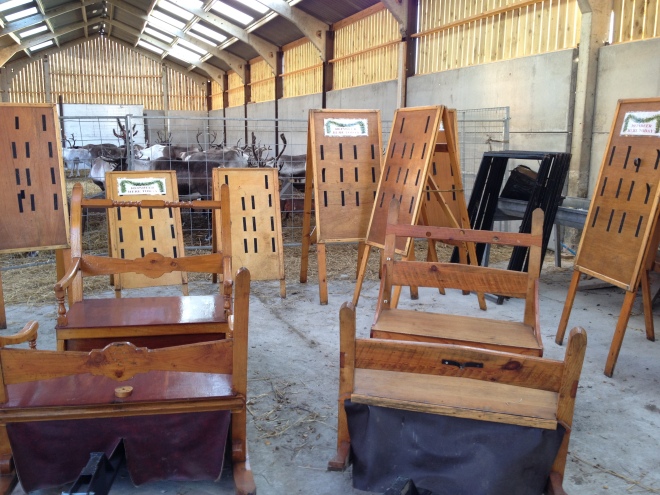Sonya, author of this blog, came up to us in June to volunteer with our beautiful reindeer. She has very kindly written us a blog about her experience, and we will be sharing it over the next few weeks. Thanks so much to Sonya for coming along and being so helpful, and we really hope to see you again in the not too distant future!
Day One
In June 2016 I arrived for my volunteer placement at the Cairngorm Reindeer Centre in Glenmore with no previous experience of working with animals but lots of enthusiasm and affection for the reindeer I had visited as a tourist many times before. I had recently taken the opportunity to take voluntary redundancy from my 20 year career and had a whole summer to fill before starting university in September. I had no idea what to expect but was seeking solace and comfort in the remoteness of the fabulous Cairngorms and the company of the placid reindeer. I was blessed with a rare dry day on the first Monday and arrived promptly at 8am alongside fellow herders Imogen who has a zoology degree and big-bearded Dave who I later found out to be exceedingly well travelled and originally from New Zealand. By the way, it’s the beard that’s big, not Dave himself.
So after meeting a confusing muddle of strangely named dogs, I was introduced to Fiona who runs the Centre, and tasks were allocated for the morning. Can you guess what my first job was? That’s right…. reindeer poop scooping. Keen to carry out all necessary tasks enthusiastically, I wielded the bespoke pooper scooper and collected a remarkable bucketful of the stuff from the paddocks. A few of the herd are kept in the paddocks for two weeks at a time so they are more accessible to very young, old or less-able visitors who can’t manage the hill trip to see the whole herd. After scooping all the poop I could find, transferring the contents of the bucket to a sack was a trickier and less appealing task but the trusty Dave was on hand to show how it’s done without spilling too much. I confess from that moment on I found myself a pair of gloves for this task and many others, much to Dave’s derision, I suspect. But hey, you can take the girl out of Essex………
I had a full and detailed explanation from Dave on how to open up the exhibition ready for visitors and spent some time replenishing the children’s craft materials, I wish I was 5 years old again so that I could make paper chains or make an antler headband, and draw colourful pictures of my reindeer friends. However, with pencils sharpened, loan wellies sorted into sizes and the shop vacuumed, it was time to set off on the first hill trip. The tourists were very impressed with Dave’s authentic appearance of bushy beard and battered green hat and took several photos of him and the van before we even set off. I’m convinced I need to change my image, which currently consists of generic walking attire, so as to appeal to the tourists but I am stuck for inspiration, more of this later.
On the first hill trip the cheeky Svalbard is overly friendly and pushes and prods me repeatedly with his antlers and nose. The tourists mistake his behaviour for affection and there are many oohs and aahs and clicks of cameras, however it’s far more likely that he recognised the smell of food on the jacket I was borrowing from the Reindeer Centre.

I also learnt that my adoptee ‘Gandi’ is there somewhere, in amongst the swirling sea of moulting coats and velvet antlers that greeted us. Correction, they are greeting the sack of food, not us, and I have learnt they couldn’t care less about us or how the food gets there. Despite this pragmatic realisation, I am still deluding myself that Gandi recognised me, if he could talk he’d even remember my name, of course!

I am delighted and relieved to see him in such good health with a remarkably majestic pair of antlers. I feel inordinately proud that I chose such a worthy recipient of my sponsorship, for he is also a recent TV star in the BBC Scotland programme about the Highlands due to be shown across other BBC regions in Autumn 2016.
After lunch Dave teaches me how to mix the reindeer food, I was keen to get started as I love a piece of machinery and rather ingeniously, I thought, a cement mixer is used to mix the food. And when you realise the quantity of food they get through, you realise why it’s necessary to mechanise the process. There is little demand for a commercially available reindeer food, as this is the only large free-ranging herd in the UK, so I was shown the recipe and the shed full of ingredients. We started with sheep food containing corn and grains, then added extra barley, some starchy sugar beet, some fibrous malt pellets which are a waste product from the numerous nearby distilleries, added a sprinkle of a secret mineral supplement and four big handfuls of hay enriched with garlic and molasses. Well this was all fascinating for me and I was enjoying making this tasty treat until we ran out of grain. Dave despatched me to the shed to fetch more barley, all good so far. I located the barley and saw with some dismay how huge the new sack was. I should mention at this point that I only manage to measure five feet with my shoes on, and the heaviest thing I’d lifted in my previous job was a bottle of Chanel No 5! Battle with the barley sack commenced but I should have been grateful for small mercies as some of the other ingredients are much heavier.

By the time we had mixed about half a cubic metre of food, it was a relief to leave behind the previously fascinating cement mixer, and head up to the hill again on the 2:30pm trip. Dave encouraged me to carry the sack of food but I chickened out and took the lighter and smaller sack of hand feed. Poor Dave gets the bigger, heavier sack yet again, but gallantry isn’t completely dead in my world!
Near the end of the trip Dave gets a phone call, we’re a 20 min walk from the nearest road and goodness knows how far from the nearest dwelling but amazingly there’s a mobile signal in the reindeer enclosure. I can’t always get one of those in flat, overpopulated Essex. Anyway the phone call is to invite me to the reindeer shed to see some vaccinations taking place where I met the famous Tilly, Fiona’s mum and owner of the herd. The injection is to help prevent the potentially fatal red water fever that can kill a reindeer if not caught early enough. Imogen had previously told me that Tilly always comes to administer these injections as there is a tiny chance the reindeer will go into anaphylactic shock and she has the most experience to deal with that possibility. Despite their huge antlers and sharp hooves, I had never felt even remotely intimidated by reindeer before. But closed in a tiny shed with six of them circling round and round in an effort to escape the needle, it felt a bit like being caught up in a whirling dervish of hoof and hair and taught me a greater respect for the fact they are still wild animals even though they generously humour us with their presence and grace.
Day Two
Tuesday starts with much excitement and anticipation when Fiona tells me I can join her and Hen on a harness training session. Hen is the longest serving herder based at Reindeer House other than Fiona and I found out she can recognise and name every single reindeer, as can most of the herders. However, if a pair of antlers are cast in the autumn, Hen knows which reindeer they belonged to as she recognises the distinct and unique form of each and every reindeer’s antlers even when they’re no longer on the animal. The Cairngorm reindeer participate in many Christmas events across the country and it’s important they keep practising with the halter and harness throughout the year so that Christmas is a relaxed affair with no anxiety. Another treat for me is that my adoptee Gandi is one of the reindeer coming along on the practice session because he and Elvis are experienced trekkers and will set a good example to Camus, Balmoral and Shinty. I hadn’t met the last three reindeer before and I’m pleased to say they all did very well with their training. Shinty was the most reluctant to get going and he gave Hen a thorough workout by making her tug him up the hill, but with Gandi encouraging him from behind, we were soon underway on our circuit.

So this is Hen on the left and me on the right with reindeer (from left to right) Elvis, Shinty, Gandi, Camus and Balmoral. It was to be the last glimpse of the sun for several days so I’m glad I took up Fiona’s offer to take a photo of me with the reindeer and I sent it to my ex-colleagues to illustrate the dramatic difference to my working day.
The rest of the day was spent on hill trips with tourists, becoming more familiar with the information we impart to the eager visitors. Many people meet a favourite reindeer on their visit, as I did with Gandi, and decide to adopt them. In between the trips we all work on the biannual newsletter as it’s time to send it out to all the reindeer adopters. This edition of the newsletter features many tales of the reindeer and activities and events at the centre. There are some hilarious stories about Fergus, a hand-reared calf who has turned out to be a very cheeky boy indeed, and sadly, there’s a moving obituary to Grunter, a much loved reindeer who was also hand-reared when he was a calf.
I’ve learnt the name of another member of the herd today, the endearing Blue, who was named in the year of cheeses 2013. He was born with a condition which means he is very pale, almost completely white and he’s also deaf. Many visitors think he is albino but Imogen explained to me that albinism means a complete lack of pigment, whereas Blue just has a reduced level of pigment which means he is Leucistic. His skin is very pink and prone to sunburn and any broken skin could lead to infection so he has bright yellow ‘summer cream’ on his face which is a mix of sunscreen and insecticide to keep the midges away. Blue has been a bit slow to come for food today and hasn’t hand fed from the tourists as much as normal so on one of my hill trips with Imogen, it’s necessary to take his temperature once the visitors are gone. I’ve seen this before and it involves luring them close with an irresistible bucket of lichen to get a halter on them, one person holds the head while the other person takes the temperature from the ‘other end’. Whilst Imogen does the ‘business’ she regales me with detailed advice about insertion of the thermometer, which angle is best, how long to leave it in, etc. I decide it’s time to manage her expectations and make it clear, I’m happy to learn the theory, but as far as practise goes, I think I’ll remain at the head end, thank you very much!


Today I also discussed with Imogen how I could possibly look less like a tourist when we take the visitors out. Her insightful but wildly impractical suggestion is that I should dress for conditions at least ten degrees warmer, so go up the hill in just a t-shirt when everyone else is in hats and jackets, and claim it’s a warm day. I fear this soft southerner might catch her death if she attempted that, so I bear it in mind but keep my multiple layers firmly in place.
Sonya
Stay tuned for part 2 of Sonya’s blog, which will be out in a couple of weeks!




























